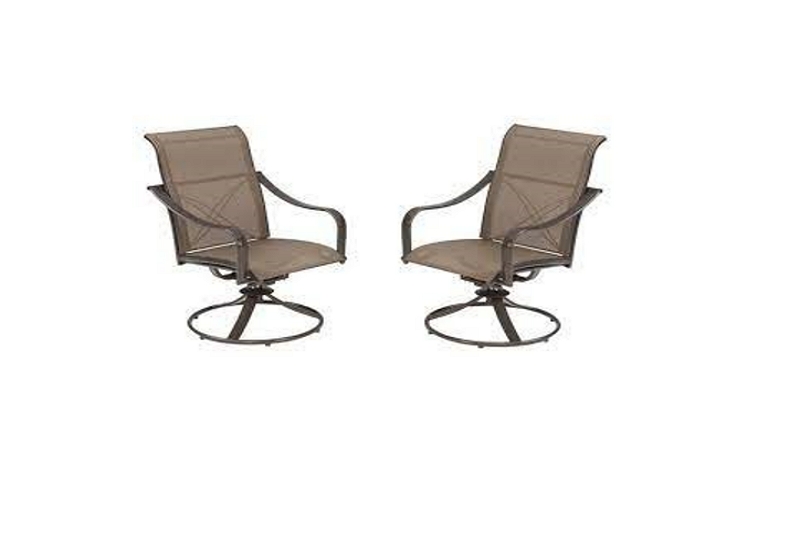The swivel chair is a classic piece of outdoor furniture that many people enjoy. However, sometimes the chair will not stay in place and the person using it will have to sit on one side or the other to avoid being thrown off. This how-to guide will show how you can repair a swivel patio chair so that it stays put when you are sitting on it!

Steps on Repairing Swivel Patio Chair
Step One: Unscrew the broken part of the chair from the remaining parts. Use a screwdriver or pliers to do this, as it will be difficult if not impossible without them!
The swivel chair is made up of two pieces that usually attach near one end (the top) and another at its bottom. Unscrew the screws that hold these two pieces together and then pull them apart.
Step Two: Put in a new screw to replace the broken one. If you are replacing one of the top screws, put it into place with your fingers at first. Then tighten it using pliers or another wrench tool. Repeat this for any other loose screws!
Step Three: Put the two pieces of your swivel chair back together, using the same technique as when you took them apart.
Step Four: Put all screws into place to ensure that they are not loose or jiggling around. You should also check how securely it is attached at either end before you use it again!
Tips for a more successful repair job include wearing some work gloves and making sure there isn’t too much excess glue on any part of the piece where it was broken off from.
If this doesn’t solve your problem then take a look at how to fix patio chairs with missing parts instead!
How do you fix a Rusty Swivel Chair?
Step 1. First, find the screws that hold your chair together. They are usually located on the underside of the frame or in a hole near one of the legs. If you don’t see any, look for them around the seat and back support area to be sure they’re present but not visible from an outside view.
Step 2. Take those screws out with either a screwdriver or socket wrench (hand tighten only). There might also be another set inside holes opposite where you just removed some screws–taking these off will take less time than if they were left alone! Be careful when removing as this could cause more rusting because it pushes air into crevices. Use gloves if possible, too!
Once all bolts have been taken out, remove the seat from where it’s mounted. Lift on one end of the chair while sliding out a long metal bar that runs underneath–you should see how this is done because there will be two screws holding onto each side, and they need to come off as well.
Keep in mind how it was assembled before taking it apart so you can put it back together again without frustration! If all else fails, refer to your original instructions or call customer service for further assistance.
Step 3. You’ll now want to take these bars and slide them through any other holes present near the frame (not those close to the legs). They might not have been in use yet depending on how rusty your item has become–check around for loose ones with this design.
Step 4. You’ll want to insert these bars into the hole on either side of the chair, and then tighten them using a screwdriver or wrench (you can also use pliers). The tighter you make it fit in place, the better your result will be when coming back for reassembly.
Don’t overdo it though because this could cause some tension with how well your chair works after putting it all together!
Step 5. Once that’s done, take off any excess bar sticking out past where they should go–this is going to give us more room to work around while we’re trying to assemble everything else without causing damage.
Step 6. Now there are four remaining slots: two at both sides of the seat frame and one each on the backside of both legs.
Step 7. Starting with the back slots, take your adjustment bar and put in one end on each slot so they’re laying flat across them–one at a time if you can’t fit all four at once. Push down firmly to lock it into place, but don’t push too hard or else you’ll bend the frame outwards! We’ve got more work to do before we worry about how much pressure is enough for this step anyway.
Step 8. Now that our bars are ready, flip over your seat assembly onto its base; then use any kind of screwdriver (or electrical tester!) to find an access point under where your leg goes through. The screws might be hidden by some rubber caps which you can pry off.
It’s a good idea to use the same size of the screwdriver as those you’re using–if not, they might break or strip out when we try to turn them and force open the chair!
You’ll see how one end is threaded while the other has a little plastic nub that fits into an empty slot on the frame; this clip will keep everything together tightly once our work is done here. Use pliers to hold onto these threads because their suitability in quality may make all difference.
